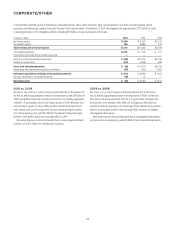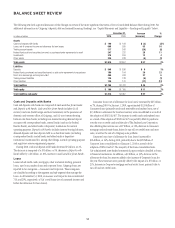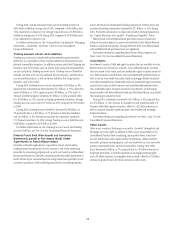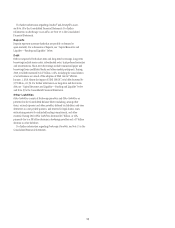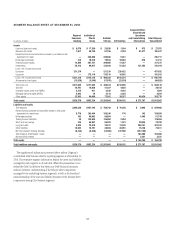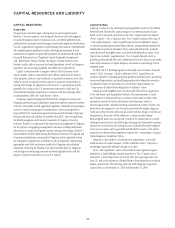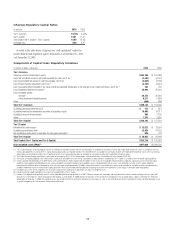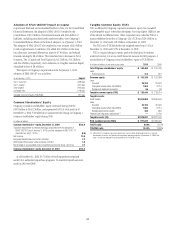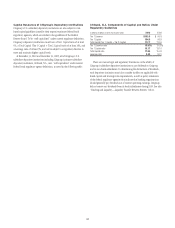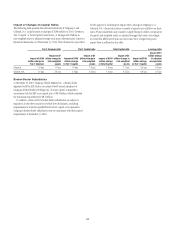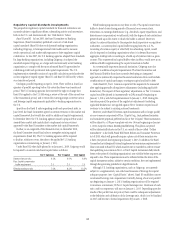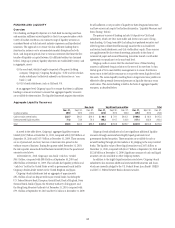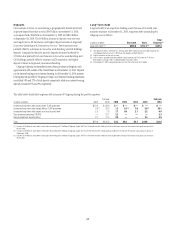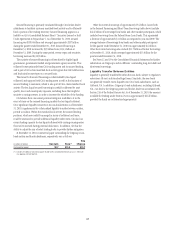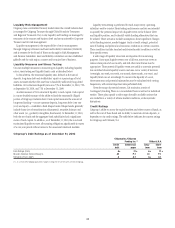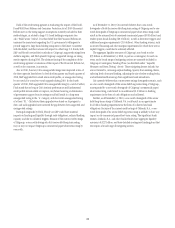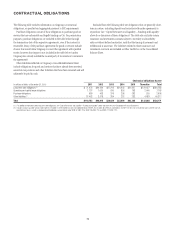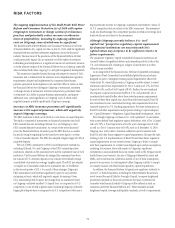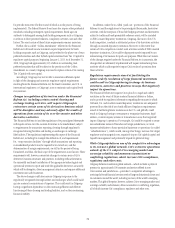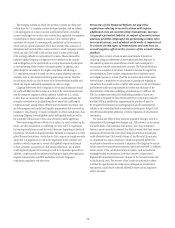Citibank 2010 Annual Report Download - page 65
Download and view the complete annual report
Please find page 65 of the 2010 Citibank annual report below. You can navigate through the pages in the report by either clicking on the pages listed below, or by using the keyword search tool below to find specific information within the annual report.
63
Regulatory Capital Standards Developments
The prospective regulatory capital standards for financial institutions are
currently subject to significant debate, rulemaking activity and uncertainty,
both in the U.S. and internationally. See “Risk Factors” below.
Basel II and III. In late 2005, the Basel Committee on Banking
Supervision (Basel Committee) published a new set of risk-based
capital standards (Basel II) that would permit banking organizations,
including Citigroup, to leverage internal risk models used to measure
credit, operational, and market risk exposures to drive regulatory capital
calculations. In late 2007, the U.S. banking agencies adopted these standards
for large banking organizations, including Citigroup. As adopted, the
standards require Citigroup, as a large and internationally active banking
organization, to comply with the most advanced Basel II approaches for
calculating credit and operational risk capital requirements. The U.S.
implementation timetable consists of a parallel calculation period under the
current regulatory capital regime (Basel I) and Basel II, followed by a three-
year transitional period.
Citi began parallel reporting on April 1, 2010. There will be at least four
quarters of parallel reporting before Citi enters the three-year transitional
period. The U.S. banking agencies have reserved the right to change how
Basel II is applied in the U.S. following a review at the end of the second year
of the transitional period, and to retain the existing prompt corrective action
and leverage capital requirements applicable to banking organizations in
the U.S.
Apart from the Basel II rules regarding credit and operational risks, in
June 2010, the Basel Committee agreed on certain revisions to the market risk
capital framework that would also result in additional capital requirements.
In December 2010, the U.S. banking agencies issued a proposal that would
amend their market risk capital rules to implement certain revisions
approved by the Basel Committee to the market risk capital framework.
Further, as an outgrowth of the financial crisis, in December 2010,
the Basel Committee issued final rules to strengthen existing capital
requirements (Basel III). The U.S. banking agencies will be required
to finalize, within two years, the rules to be applied by U.S. banking
organizations commencing on January 1, 2013.
Under Basel III, when fully phased in on January 1, 2019, Citigroup would
be required to maintain risk-based capital ratios as follows:
Tier 1 Common Tier 1 Capital Total Capital
Stated minimum ratio 4.5% 6.0% 8.0%
Plus: Capital conservation
buffer requirement 2.5 2.5 2.5
Effective minimum ratio 7.0% 8.5% 10.5%
While banking organizations may draw on the 2.5% capital conservation
buffer to absorb losses during periods of financial or economic stress,
restrictions on earnings distributions (e.g., dividends, equity repurchases, and
discretionary compensation) would result, with the degree of such restrictions
greater based upon the extent to which the buffer is utilized. Moreover,
subject to national discretion by the respective bank supervisory or regulatory
authorities, a countercyclical capital buffer ranging from 0% to 2.5%,
consisting of common equity or other fully loss absorbing capital, would
also be imposed on banking organizations when it is deemed that excess
aggregate credit growth is resulting in a build-up of systemic risk in a given
country. This countercyclical capital buffer, when in effect, would serve as an
additional buffer supplementing the capital conservation buffer.
As a systemically important financial institution, Citigroup may also
be subject to additional capital requirements. The Basel Committee and
the Financial Stability Board are currently developing an integrated
approach to systemically important financial institutions that could include
combinations of capital surcharges, contingent capital and bail-in debt.
Under Basel III, Tier 1 Common capital will be required to be measured
after applying generally all regulatory adjustments (including applicable
deductions). The impact of these regulatory adjustments on Tier 1 Common
capital would be phased in incrementally at 20% annually beginning on
January 1, 2014, with full implementation by January 1, 2018. During the
transition period, the portion of the regulatory adjustments (including
applicable deductions) not applied against Tier 1 Common capital would
continue to be subject to existing national treatments.
Moreover, under Basel III certain capital instruments will no longer qualify
as non-common components of Tier 1 Capital (e.g., trust preferred securities
and cumulative perpetual preferred stock) or Tier 2 Capital. These instruments
will be subject to a 10% per-year phase-out over 10 years beginning on January
1, 2013, except for certain limited grandfathering. This phase-out period
will be substantially shorter in the U.S. as a result of the so-called “Collins
Amendment” to the Dodd-Frank Wall Street Reform and Consumer Protection
Act of 2010, which will generally require a phase out of these securities over
a three-year period also beginning on January 1, 2013. In addition, the Basel
Committee has subsequently issued supplementary minimum requirements to
those contained in Basel III, which must be met or exceeded in order to ensure
that qualifying non-common Tier 1 or Tier 2 Capital instruments fully absorb
losses at the point of a banking organization’s non-viability before taxpayers are
exposed to loss. These requirements must be reflected within the terms of the
capital instruments unless, subject to certain conditions, they are implemented
through the governing jurisdiction’s legal framework.
Although U.S. banking organizations, such as Citigroup, are currently
subject to a supplementary, non-risk-based measure of leverage for capital
adequacy purposes (see “Capital Ratios” above), Basel III establishes a more
constrained Leverage ratio requirement. Initially, during a four-year parallel
run beginning on January 1, 2013, banking organizations will be required
to maintain a minimum 3% Tier 1 Capital Leverage ratio. Disclosure of such
ratio, and its components, will start on January 1, 2015. Depending upon the
results of the parallel run test period, there could be subsequent adjustments
to the definition and calibration of the Leverage ratio, which is to be finalized
in 2017 and become a formal requirement by January 1, 2018.


